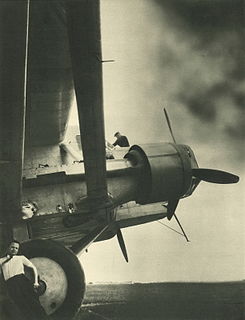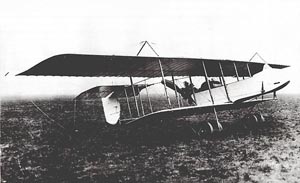Related Research Articles

The Farman F.220 and its derivatives were thick-sectioned, high-winged, four engined monoplanes from Farman Aviation Works. Based on the push-pull configuration proven by the F.211, design started in August 1925 and the first flight of the prototype was on 26 May 1932. The definitive F.222 variant was the biggest bomber to serve in France between the world wars. One variant was designed as an airliner.

Georges Levy G.L. 40 HB2 was a three-seated French, amphibious biplane aircraft that was designed in 1917. The aircraft was designed by Blanchard and Le Pen and therefore the aircraft was also known as the Levy-Le Pen. Le Pen was Maurice Jules-Marie Le Pen born in Lorient, Morbihan, France in 1889; he was killed in a car crash in 1919. It was claimed to be the best French amphibious aircraft of World War I, but that is probably due to the low scale production of such aircraft in France at that time.

The Maurice Farman MF.7 Longhorn is a French biplane developed before World War I which was used for reconnaissance by both the French and British air services in the early stages of the war before being relegated to service as a trainer.

The Maurice Farman MF.11 Shorthorn is a French aircraft developed before World War I by the Farman Aviation Works. It was used as a reconnaissance and light bomber during the early part of World War I, later being relegated to training duties.

The Farman F.170 Jabiru was a 1925 single-engine airliner evolved from the F.121 Jabiru, built by the Farman Aviation Works.

The Farman F.40 was a French pusher biplane reconnaissance aircraft.

The Farman F.200 was a civil utility aircraft produced in France in the 1930s. Derived from the F.190, it featured a revised fuselage that did away with its predecessor's enclosed cabin. Instead, it was a parasol-wing monoplane with open cockpits in tandem for the pilot and one or two passengers. Intended primarily as a trainer, it was also marketed as being suitable as a photographic platform or a mail plane.

The Farman F.300 and F.310 were airliners built in France in the early 1930s. They were high-wing strut braced monoplanes with fixed tailskid undercarriage with a trimotor layout popular with several manufacturers of the time. The cockpit and passenger compartment were fully enclosed. Most saw service in Farman's own airline, whose twelve F.300 variants made up half its fleet in 1931.

The Farman HF.20 and its derivatives were a family of reconnaissance aircraft produced in France shortly before and during the First World War. It was a refined version of the Farman MF.11 "Shorthorn" that did away with the type's distinctive landing skids, and incorporated design features from Henri Farman's designs. It entered service with the French, Belgian and Serbian armies in 1913, and with the British RFC and RNAS shortly after the outbreak of war. The type was also licence-built in the UK by Airco and Grahame-White.

The Farman NC.470 was a French twin-engined floatplane designed as a crew trainer for the French Navy. It was used in small numbers for both its intended role as a trainer and as a coastal reconnaissance aircraft at the start of World War II.

The Marinens Flyvebaatfabrikk M.F.1 was a two-seat biplane floatplane, the first aircraft produced by the Royal Norwegian Navy Air Service's aircraft factory Marinens Flyvebaatfabrikk in Horten, built after Maurice Farman's MF.7 design. The construction began in the summer of 1915, with plans borrowed from the Norwegian Army Air Service's aircraft factory at Kjeller.
The Marinens Flyvebaatfabrikk M.F.2 was a two-seat military biplane floatplane produced by Marinens Flyvebaatfabrikk in 1915 and 1916. It was designed by naval captain Halfdan Gyth Dehli, based on former models by French designer Maurice Farman and improvements by Einar Sem-Jacobsen of the Norwegian Army Air Service's aircraft factory Kjeller Flyfabrikk.

The Farman Moustique is a family of French monoplanes built by the Société des Aéroplanes Henry et Maurice Farman at Billancourt.

The Farman HF.14 was a French two seat reconnaissance type produced by Farman Aviation Works before World War I.
The Dorand DO.1 was an armoured reconnaissance-bomber designed and built in France from 1913. A small number were used operationally as a stop-gap measure.
The Maurice Farman MF.6 Shorthorn is a French tourism biplane developed by Maurice Farman before World War I.
The Maurice Farman MF.9 is a French tourism biplane developed by Maurice Farman before World War I. Like the Maurice Farman MF.6, it used floats for take-off and landing on water.
The Maurice Farman MF.16 was a French reconnaissance aircraft developed before World War I by the Farman Aviation Works.
The Farman HF.16 was a reconnaissance aircraft built in France shortly before the First World War.
The Henry Farman HF.19 was a French reconnaissance seaplane developed by Henry Farman before World War I. As a floatplane, it used floats for take-off and landing on water.
References
- ↑ "Maurice Farman MF-8 - Hydravion de tourisme - Un siècle d'aviation française". Aviafrance.com. 1999-12-13. Retrieved 2019-01-29.